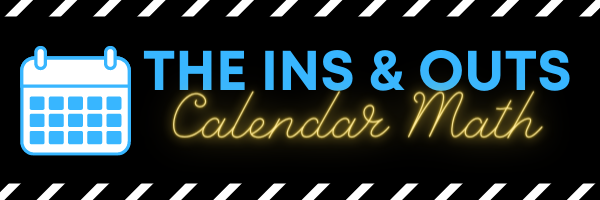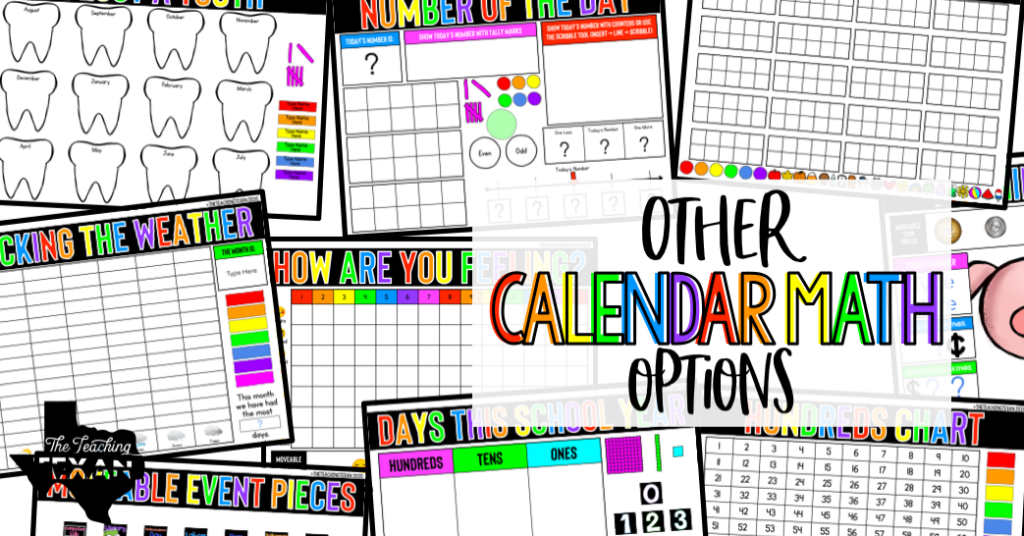The Ins and Outs of Calendar Math
Alright y’all, time to gear up for another great year. It’s definitely gonna look different this year, but no matter how it shakes down in your district, our students deserve the best educational experience we can give them and despite any difficulties goshdarnit that’s what we’re going to do!
Last year (when the world was normal), we got deep into guided reading, shared reading and independent reading — basically all things literacy centers for elementary. And now it’s time to switch it up. You’ve been asking excellent questions via social media that are math related recently, so I decided it’s time for a detailed math unit, tackling all the common issues we struggle with particularly in kindergarten and first grade (although lots of these issues are universal throughout elementary).
Here’s a quick break-down: We’ll start off today with calendar math and follow up with math warm-ups, how to differentiate, plus planning and organizing math centers (including tips on storage for all your math gadgets and accountability for students who are often working on their own). Then, we’ll get deep into guided math — where to start, mini-lessons, activities and assessment. Finally, we’ll wrap up our elementary math series with collecting and interpreting helpful data for your students that will help them succeed and grow in their skills. Along the way I’ll be sharing lots of math tips and tricks that I’ve used when teaching kindergarten, first and second grade.

But for today we’ll start with Calendar Math. Some love it. Some hate it. One response from a social media follow said, “It’s boring, I need to figure out how to spice it up because it’s so repetitive that kids zone out.” Girl, I feel ya. That’s why we’re starting here.
Because the thing is, yeah, if you’re not careful, a routine like Calendar Math can easily become rote, stale, and boring to both students and teacher alike. But the reality is that some form of calendar math (or at least a concentrated math warm-up) is truly appropriate for every elementary classroom — from kindergarten to fifth grade. Obviously the amount of time spent in calendar math and the skills practiced will vary grade to grade, but it’s SUCH a great time to talk about seasons, months of the year, upcoming events, patterns, and SO MUCH MORE.
Of course, in kindergarten and first grade, calendar math will be longer than in upper elementary, because kiddos are just learning and mastering these skills. Personally, I love to have my “leader of the day” lead calendar time. Now, this takes practice, and sometimes a LOT of patience, but it’s a great strategy to keep your kiddos invested. Plus, they look forward to their turn as leader so it makes it a really special time.
How It Works
In case you’re totally unfamiliar with calendar math, allow me a brief run-down of what we do in my classroom. Each day, first thing (unless we have specials) we start as a whole group by our classroom calendar.
We go through a routine of updating the date, adding the calendar piece for the day based on what pattern the pieces show, tallying how many students are present vs. absent, estimating (this is usually a seasonal thing and not year round), reading the morning message with the leader pointing, and end with some form of sharing.

Engage the WHOLE Brain
You may have noticed something above. Not everything we do during calendar math is actually…well…math. I do that purposefully. I intentionally vary the skills used during calendar math so that it’s not 100% “math”, but more of an overall warm-up for all parts of the brain. While yes, we’re pretty math heavy (estimating, date, patterns, tallying, etc.), I like to include some literacy skills whenever I can — you know me! — so students who may be weaker in math but strong in literacy still have a chance to shine when it’s their turn to be calendar leader.
Since calendar time is independent from math centers and our formal “math class”, I use the time as a whole brain warm-up, rather than strictly “math warm-ups”. Classifying it as a general warm-up instead of forcing us to stick to math gives me some freedom to mix it up when I notice students need something different.

Feel Free to Mix it Up
Because you know some days just start different than others. Sometimes students start the day nice and calm in kindergarten and first grade (a teacher can dream right??) and sometimes (more often) your kiddos all over the place! So, if you feel your students getting antsy or wiggly during calendar math, feel free to mix it up. One of my favorite “on the fly” activities is called TAKE DOWN. It’s great for just after (or before or during) calendar math, or any time! My kids LOVE this game, and it is SO versatile. It can be used for counting, skip counting, counting backwards, counting on, and so many other skills.

How to Play: TAKE DOWN
A quick run-down for y’all:
- Decide what skill you’re going to be working on — you can always use the date or something from the calendar for inspiration. For this example let’s say the date is the 22nd and we’ve decided to practice counting by 2’s.
- Have students stand in a circle.
- Starting with the leader, students will count in a circle (Tip: this can be a chance to review clockwise/counter-clockwise if you ask the leader which direction they’d like to go!) until they reach the number 22 (since that’s the date).
- In this example, the 11th student will say “22!” and they’ll have to sit down — they’re “out” (Tip: this is also a good opportunity to talk to your students about how this is a game of CHANCE, not a game of SKILL. They can’t do anything to win or lose, it just is what it is).
- Then the next person starts over again with 2!
- Repeat until there’s only one student standing.
BOOM — take down.
Let it Evolve
As students get older in second grade and beyond, I find myself abbreviating this time a bit. But I still believe in starting each day with some sort of “Morning Meeting” that’s a whole class activity. Older elementary students definitely benefit from this routine. Talking about the date, current and upcoming events or holidays, plus reviewing any skills that your class is working on with a quick game or recap from a student are all great ways to start the day. This is also an opportunity to have all students respond on a white board so you can assess where they are without singling out any one student. Another trick for students in upper elementary is to use calendar time as an opportunity to spiral skills, reviewing techniques learned in kindergarten and first grade — brushing up on money, for example.
If you’re looking for a digital calendar math option to use in person or while distance learning – check out my Digital Calendar Math resource with templates for PowerPoint and Google Slides ™ plus printables!

Make it Work for YOUR CLASSROOM
Personally, I like to have calendar first thing in the morning, as part of the morning meeting, as I’ve mentioned. But that’s not a set in stone rule y’all. It makes sense to my brain to do it first thing, but it can be done ANY TIME throughout the day. Make it work for you classroom and your students.
I can’t wait to hear how you utilize calendar math in your classrooms and what you do to spice it up so it’s not routine and easy to check out. Next post we’ll talk more about math warm-ups and how to make them your students’ favorite part of the day!
